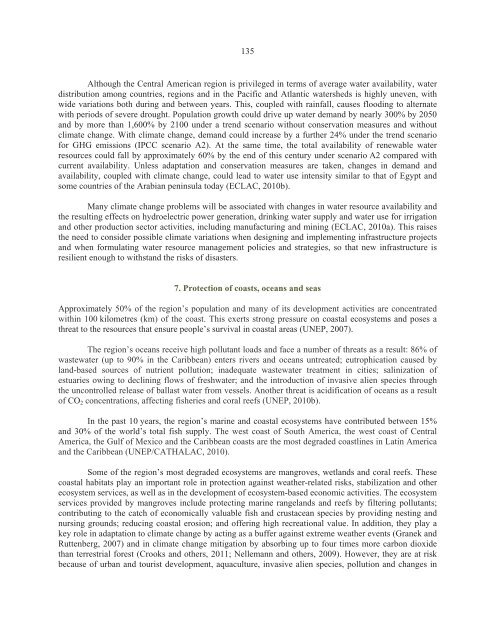sustainable development 20 years on from the ... - José Eli da Veiga
sustainable development 20 years on from the ... - José Eli da Veiga
sustainable development 20 years on from the ... - José Eli da Veiga
Create successful ePaper yourself
Turn your PDF publications into a flip-book with our unique Google optimized e-Paper software.
135<br />
Although <strong>the</strong> Central American regi<strong>on</strong> is privileged in terms of average water availability, water<br />
distributi<strong>on</strong> am<strong>on</strong>g countries, regi<strong>on</strong>s and in <strong>the</strong> Pacific and Atlantic watersheds is highly uneven, with<br />
wide variati<strong>on</strong>s both during and between <str<strong>on</strong>g>years</str<strong>on</strong>g>. This, coupled with rainfall, causes flooding to alternate<br />
with periods of severe drought. Populati<strong>on</strong> growth could drive up water demand by nearly 300% by <str<strong>on</strong>g>20</str<strong>on</strong>g>50<br />
and by more than 1,600% by 2100 under a trend scenario without c<strong>on</strong>servati<strong>on</strong> measures and without<br />
climate change. With climate change, demand could increase by a fur<strong>the</strong>r 24% under <strong>the</strong> trend scenario<br />
for GHG emissi<strong>on</strong>s (IPCC scenario A2). At <strong>the</strong> same time, <strong>the</strong> total availability of renewable water<br />
resources could fall by approximately 60% by <strong>the</strong> end of this century under scenario A2 compared with<br />
current availability. Unless a<strong>da</strong>ptati<strong>on</strong> and c<strong>on</strong>servati<strong>on</strong> measures are taken, changes in demand and<br />
availability, coupled with climate change, could lead to water use intensity similar to that of Egypt and<br />
some countries of <strong>the</strong> Arabian peninsula to<strong>da</strong>y (ECLAC, <str<strong>on</strong>g>20</str<strong>on</strong>g>10b).<br />
Many climate change problems will be associated with changes in water resource availability and<br />
<strong>the</strong> resulting effects <strong>on</strong> hydroelectric power generati<strong>on</strong>, drinking water supply and water use for irrigati<strong>on</strong><br />
and o<strong>the</strong>r producti<strong>on</strong> sector activities, including manufacturing and mining (ECLAC, <str<strong>on</strong>g>20</str<strong>on</strong>g>10a). This raises<br />
<strong>the</strong> need to c<strong>on</strong>sider possible climate variati<strong>on</strong>s when designing and implementing infrastructure projects<br />
and when formulating water resource management policies and strategies, so that new infrastructure is<br />
resilient enough to withstand <strong>the</strong> risks of disasters.<br />
7. Protecti<strong>on</strong> of coasts, oceans and seas<br />
Approximately 50% of <strong>the</strong> regi<strong>on</strong>’s populati<strong>on</strong> and many of its <str<strong>on</strong>g>development</str<strong>on</strong>g> activities are c<strong>on</strong>centrated<br />
within 100 kilometres (km) of <strong>the</strong> coast. This exerts str<strong>on</strong>g pressure <strong>on</strong> coastal ecosystems and poses a<br />
threat to <strong>the</strong> resources that ensure people’s survival in coastal areas (UNEP, <str<strong>on</strong>g>20</str<strong>on</strong>g>07).<br />
The regi<strong>on</strong>’s oceans receive high pollutant loads and face a number of threats as a result: 86% of<br />
wastewater (up to 90% in <strong>the</strong> Caribbean) enters rivers and oceans untreated; eutrophicati<strong>on</strong> caused by<br />
land-based sources of nutrient polluti<strong>on</strong>; inadequate wastewater treatment in cities; salinizati<strong>on</strong> of<br />
estuaries owing to declining flows of freshwater; and <strong>the</strong> introducti<strong>on</strong> of invasive alien species through<br />
<strong>the</strong> unc<strong>on</strong>trolled release of ballast water <strong>from</strong> vessels. Ano<strong>the</strong>r threat is acidificati<strong>on</strong> of oceans as a result<br />
of CO 2 c<strong>on</strong>centrati<strong>on</strong>s, affecting fisheries and coral reefs (UNEP, <str<strong>on</strong>g>20</str<strong>on</strong>g>10b).<br />
In <strong>the</strong> past 10 <str<strong>on</strong>g>years</str<strong>on</strong>g>, <strong>the</strong> regi<strong>on</strong>’s marine and coastal ecosystems have c<strong>on</strong>tributed between 15%<br />
and 30% of <strong>the</strong> world’s total fish supply. The west coast of South America, <strong>the</strong> west coast of Central<br />
America, <strong>the</strong> Gulf of Mexico and <strong>the</strong> Caribbean coasts are <strong>the</strong> most degraded coastlines in Latin America<br />
and <strong>the</strong> Caribbean (UNEP/CATHALAC, <str<strong>on</strong>g>20</str<strong>on</strong>g>10).<br />
Some of <strong>the</strong> regi<strong>on</strong>’s most degraded ecosystems are mangroves, wetlands and coral reefs. These<br />
coastal habitats play an important role in protecti<strong>on</strong> against wea<strong>the</strong>r-related risks, stabilizati<strong>on</strong> and o<strong>the</strong>r<br />
ecosystem services, as well as in <strong>the</strong> <str<strong>on</strong>g>development</str<strong>on</strong>g> of ecosystem-based ec<strong>on</strong>omic activities. The ecosystem<br />
services provided by mangroves include protecting marine rangelands and reefs by filtering pollutants;<br />
c<strong>on</strong>tributing to <strong>the</strong> catch of ec<strong>on</strong>omically valuable fish and crustacean species by providing nesting and<br />
nursing grounds; reducing coastal erosi<strong>on</strong>; and offering high recreati<strong>on</strong>al value. In additi<strong>on</strong>, <strong>the</strong>y play a<br />
key role in a<strong>da</strong>ptati<strong>on</strong> to climate change by acting as a buffer against extreme wea<strong>the</strong>r events (Granek and<br />
Ruttenberg, <str<strong>on</strong>g>20</str<strong>on</strong>g>07) and in climate change mitigati<strong>on</strong> by absorbing up to four times more carb<strong>on</strong> dioxide<br />
than terrestrial forest (Crooks and o<strong>the</strong>rs, <str<strong>on</strong>g>20</str<strong>on</strong>g>11; Nellemann and o<strong>the</strong>rs, <str<strong>on</strong>g>20</str<strong>on</strong>g>09). However, <strong>the</strong>y are at risk<br />
because of urban and tourist <str<strong>on</strong>g>development</str<strong>on</strong>g>, aquaculture, invasive alien species, polluti<strong>on</strong> and changes in













